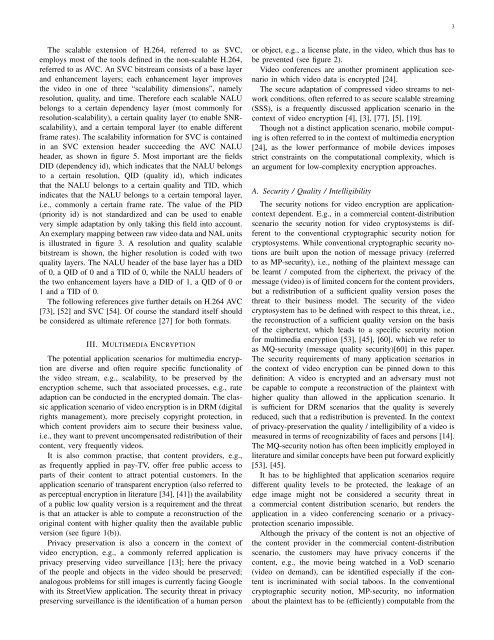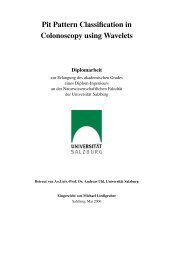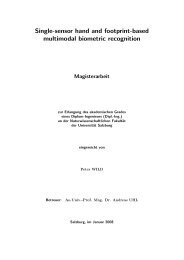A Survey of H.264 AVC/SVC Encryption
A Survey of H.264 AVC/SVC Encryption
A Survey of H.264 AVC/SVC Encryption
Create successful ePaper yourself
Turn your PDF publications into a flip-book with our unique Google optimized e-Paper software.
3The scalable extension <strong>of</strong> <strong>H.264</strong>, referred to as <strong>SVC</strong>,employs most <strong>of</strong> the tools defined in the non-scalable <strong>H.264</strong>,referred to as <strong>AVC</strong>. An <strong>SVC</strong> bitstream consists <strong>of</strong> a base layerand enhancement layers; each enhancement layer improvesthe video in one <strong>of</strong> three “scalability dimensions”, namelyresolution, quality, and time. Therefore each scalable NALUbelongs to a certain dependency layer (most commonly forresolution-scalability), a certain quality layer (to enable SNRscalability),and a certain temporal layer (to enable differentframe rates). The scalability information for <strong>SVC</strong> is containedin an <strong>SVC</strong> extension header succeeding the <strong>AVC</strong> NALUheader, as shown in figure 5. Most important are the fieldsDID (dependency id), which indicates that the NALU belongsto a certain resolution, QID (quality id), which indicatesthat the NALU belongs to a certain quality and TID, whichindicates that the NALU belongs to a certain temporal layer,i.e., commonly a certain frame rate. The value <strong>of</strong> the PID(priority id) is not standardized and can be used to enablevery simple adaptation by only taking this field into account.An exemplary mapping between raw video data and NAL unitsis illustrated in figure 3. A resolution and quality scalablebitstream is shown, the higher resolution is coded with twoquality layers. The NALU header <strong>of</strong> the base layer has a DID<strong>of</strong> 0, a QID <strong>of</strong> 0 and a TID <strong>of</strong> 0, while the NALU headers <strong>of</strong>the two enhancement layers have a DID <strong>of</strong> 1, a QID <strong>of</strong> 0 or1 and a TID <strong>of</strong> 0.The following references give further details on <strong>H.264</strong> <strong>AVC</strong>[73], [52] and <strong>SVC</strong> [54]. Of course the standard itself shouldbe considered as ultimate reference [27] for both formats.III. MULTIMEDIA ENCRYPTIONThe potential application scenarios for multimedia encryptionare diverse and <strong>of</strong>ten require specific functionality <strong>of</strong>the video stream, e.g., scalability, to be preserved by theencryption scheme, such that associated processes, e.g., rateadaption can be conducted in the encrypted domain. The classicapplication scenario <strong>of</strong> video encryption is in DRM (digitalrights management), more precisely copyright protection, inwhich content providers aim to secure their business value,i.e., they want to prevent uncompensated redistribution <strong>of</strong> theircontent, very frequently videos.It is also common practise, that content providers, e.g.,as frequently applied in pay-TV, <strong>of</strong>fer free public access toparts <strong>of</strong> their content to attract potential customers. In theapplication scenario <strong>of</strong> transparent encryption (also referred toas perceptual encryption in literature [34], [41]) the availability<strong>of</strong> a public low quality version is a requirement and the threatis that an attacker is able to compute a reconstruction <strong>of</strong> theoriginal content with higher quality then the available publicversion (see figure 1(b)).Privacy preservation is also a concern in the context <strong>of</strong>video encryption, e.g., a commonly referred application isprivacy preserving video surveillance [13]; here the privacy<strong>of</strong> the people and objects in the video should be preserved;analogous problems for still images is currently facing Googlewith its StreetView application. The security threat in privacypreserving surveillance is the identification <strong>of</strong> a human personor object, e.g., a license plate, in the video, which thus has tobe prevented (see figure 2).Video conferences are another prominent application scenarioin which video data is encrypted [24].The secure adaptation <strong>of</strong> compressed video streams to networkconditions, <strong>of</strong>ten referred to as secure scalable streaming(SSS), is a frequently discussed application scenario in thecontext <strong>of</strong> video encryption [4], [3], [77], [5], [19].Though not a distinct application scenario, mobile computingis <strong>of</strong>ten referred to in the context <strong>of</strong> multimedia encryption[24], as the lower performance <strong>of</strong> mobile devices imposesstrict constraints on the computational complexity, which isan argument for low-complexity encryption approaches.A. Security / Quality / IntelligibilityThe security notions for video encryption are applicationcontextdependent. E.g., in a commercial content-distributionscenario the security notion for video cryptosystems is differentto the conventional cryptographic security notion forcryptosystems. While conventional cryptographic security notionsare built upon the notion <strong>of</strong> message privacy (referredto as MP-security), i.e., nothing <strong>of</strong> the plaintext message canbe learnt / computed from the ciphertext, the privacy <strong>of</strong> themessage (video) is <strong>of</strong> limited concern for the content providers,but a redistribution <strong>of</strong> a sufficient quality version poses thethreat to their business model. The security <strong>of</strong> the videocryptosystem has to be defined with respect to this threat, i.e.,the reconstruction <strong>of</strong> a sufficient quality version on the basis<strong>of</strong> the ciphertext, which leads to a specific security notionfor multimedia encryption [53], [45], [60], which we refer toas MQ-security (message quality security)[60] in this paper.The security requirements <strong>of</strong> many application scenarios inthe context <strong>of</strong> video encryption can be pinned down to thisdefinition: A video is encrypted and an adversary must notbe capable to compute a reconstruction <strong>of</strong> the plaintext withhigher quality than allowed in the application scenario. Itis sufficient for DRM scenarios that the quality is severelyreduced, such that a redistribution is prevented. In the context<strong>of</strong> privacy-preservation the quality / intelligibility <strong>of</strong> a video ismeasured in terms <strong>of</strong> recognizability <strong>of</strong> faces and persons [14].The MQ-security notion has <strong>of</strong>ten been implicitly employed inliterature and similar concepts have been put forward explicitly[53], [45].It has to be highlighted that application scenarios requiredifferent quality levels to be protected, the leakage <strong>of</strong> anedge image might not be considered a security threat ina commercial content distribution scenario, but renders theapplication in a video conferencing scenario or a privacyprotectionscenario impossible.Although the privacy <strong>of</strong> the content is not an objective <strong>of</strong>the content provider in the commercial content-distributionscenario, the customers may have privacy concerns if thecontent, e.g., the movie being watched in a VoD scenario(video on demand), can be identified especially if the contentis incriminated with social taboos. In the conventionalcryptographic security notion, MP-security, no informationabout the plaintext has to be (efficiently) computable from the








